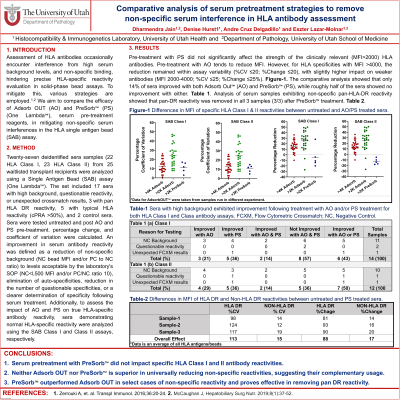Back

(P610) Comparative analysis of serum pretreatment strategies to remove non-specific serum interference in HLA antibody assessment
Location: Platinum Ballroom

Poster Presenter(s)
Aim: Assessment of HLA antibodies occasionally encounter interference from high serum background levels, and non-specific binding, hindering precise HLA-specific reactivity evaluation in solid-phase bead assays. To mitigate this, various strategies are employed. We aim to compare the efficacy of Adsorb OUTTM (AO) and PreSorb™ (PS) (One Lambda™), serum pre-treatment reagents, in mitigating non-specific serum interferences in the HLA single antigen bead (SAB) assay.
Method: Twenty-seven deidentified sera (22 HLA Class I, and 23 HLA Class II) from 25 waitlist transplant recipients were run with SAB assay (One Lambda™). This comprised 17 sera exhibiting either high background, questionable reactivity or unexpected crossmatch results, 3 with pan HLA DR antigen reactivity, 5 with normal HLA-specific reactivity (cPRA >50%) and 2 control sera (negative and positive). Sera were evaluated untreated and after AO and PS pre-treatment. The percent coefficient of variation (CV) and percent change were calculated by averaging values across beads with clinically meaningful mean fluorescence intensity (MFI) (>2000).
Results: Pre-treatment with PS showed no MFI alteration in specific HLA Class I and II reactivities compared to untreated samples (CV ≤ 10%; Change ≤ 17%), and remained within acceptable variation of assay ( <20%) (Table-1). Qualitative analysis revealed only 14% of sera improved with both AO and PS, while 57% of Class I and 36% of Class II sera showed no improvement with either reagent. Though, greater number of sera improved with PS pre-treatment (10 vs. 7), approximately half of Class I and II sera improved with only one reagent (Table 2). Notably, PS-treated samples showed undetectable non-specific pan DR reactivity (3/3), with significantly reduced HLA DR antibodies' MFI (CV = 113%; Change = 88%), while MFI of non-HLA DR (HLA DQ and DP) specificities remained unaffected (CV = 15%; Change = 17%) (Table 3).
Conclusion: In summary, serum pretreatment with PreSorb did not impact specific HLA Class I and II reactivities. Neither Adsorb OUTTM nor PreSorb demonstrated consistent superiority in universally reducing non-specific reactivities, suggesting their complementary usage. However, PS outperformed AO in select cases of non-specific reactivity and proves effective in removing pan DR reactivity in clinical settings.
Method: Twenty-seven deidentified sera (22 HLA Class I, and 23 HLA Class II) from 25 waitlist transplant recipients were run with SAB assay (One Lambda™). This comprised 17 sera exhibiting either high background, questionable reactivity or unexpected crossmatch results, 3 with pan HLA DR antigen reactivity, 5 with normal HLA-specific reactivity (cPRA >50%) and 2 control sera (negative and positive). Sera were evaluated untreated and after AO and PS pre-treatment. The percent coefficient of variation (CV) and percent change were calculated by averaging values across beads with clinically meaningful mean fluorescence intensity (MFI) (>2000).
Results: Pre-treatment with PS showed no MFI alteration in specific HLA Class I and II reactivities compared to untreated samples (CV ≤ 10%; Change ≤ 17%), and remained within acceptable variation of assay ( <20%) (Table-1). Qualitative analysis revealed only 14% of sera improved with both AO and PS, while 57% of Class I and 36% of Class II sera showed no improvement with either reagent. Though, greater number of sera improved with PS pre-treatment (10 vs. 7), approximately half of Class I and II sera improved with only one reagent (Table 2). Notably, PS-treated samples showed undetectable non-specific pan DR reactivity (3/3), with significantly reduced HLA DR antibodies' MFI (CV = 113%; Change = 88%), while MFI of non-HLA DR (HLA DQ and DP) specificities remained unaffected (CV = 15%; Change = 17%) (Table 3).
Conclusion: In summary, serum pretreatment with PreSorb did not impact specific HLA Class I and II reactivities. Neither Adsorb OUTTM nor PreSorb demonstrated consistent superiority in universally reducing non-specific reactivities, suggesting their complementary usage. However, PS outperformed AO in select cases of non-specific reactivity and proves effective in removing pan DR reactivity in clinical settings.

